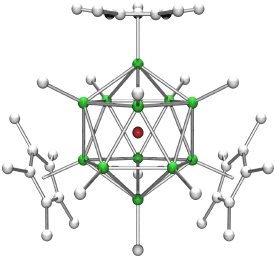They turned out to be steelworkers, running their steel mill in the nanoworld - the chemists around Prof. Dr. Roland A. Fischer (faculty of chemistry of RUB). In the neverland between molecule and metal they discovered a new family of compounds. The prototype of these new “nano alloys” is a compound containing one central molybdenum atom binding twelve zinc atoms.
 Mo(ZnR)12: The quantum theoretical analysis of Prof. Dr. Gernot Frenking (Marburg) confirms that the radial bonds between molybdenum and zinc are strong whereas the peripheric zinc atoms bind barely to each other.
Mo(ZnR)12: The quantum theoretical analysis of Prof. Dr. Gernot Frenking (Marburg) confirms that the radial bonds between molybdenum and zinc are strong whereas the peripheric zinc atoms bind barely to each other.
The icosahedral metal chunk is wrapped into hydrocarbons and therefore surprisingly stable. Its construction is transferable to both other metal centers and other structures. Also the zinc atoms can be exchanged to other metal atoms, even to gold. The scientists report about this simultaneously in the title story of “Angewandte Chemie” and in “Chemistry & Engineering News” of the American Chemical Society.
Galvanized and gilded metal atoms
Gregorius Agricolas famous opus of the year 1556 about mining and metallurgy contained the knowledge of metallurgy at his time. De re metallica would also be a good title for a present chemistry textbook, keeping in mind that four fifth of all elements in the periodic table are metals. Zinc is an exceptional metal for alloys, e.g. brass is just a mixture of copper and zinc. On the atomic level the “alloying” is related to the formation of metal clusters, small chunks made of several metal atoms. A central metal atom binds other metal atoms leading to a structure which contains exactly the number of corners as atoms bound to the central atom. According to the binding properties of the metal atoms higher structures are formed. “Of particular beauty is the icosahedron, a structure made of twenty equilateral triangles”, says Prof. Fischer. “It represents the highest symmetric platonic body.” The newly discovered molecule exhibits exactly this structure, in which a molybdenum atom holds a dozen of zinc atoms. The scientists discovered that other metal atoms like iron, nickel and platinum can be similarly galvanized in a molecular way, they can be even gilded.
Molecular metallography
The discovered icosahedron (Mo(ZnR)12) is related rather closely to tetrahedral methane (CH4): The ZnR units bound to the central molybdenum behave analogously to the hydrogen atoms in methane. The quantum theoretical analysis of Prof. Dr. Gernot Frenking (Marburg) confirms that the radial bonds between molybdenum and zinc are strong whereas the peripheric zinc atoms bind barely to each other. Therefore zinc can be exchanged by other metals, even by gold. This matches with the property of metals to form alloys. For a modeling of this phenomenon on a molecular level new synthetic methods are discovered now. The new molecules help to understand the chemical binding properties between metal atoms and are also interesting as precursors for catalysts